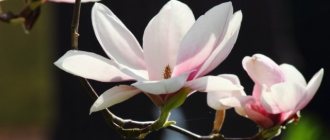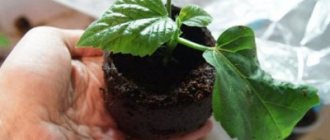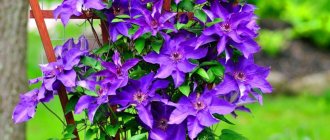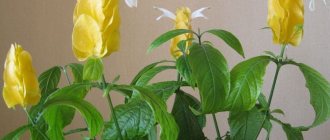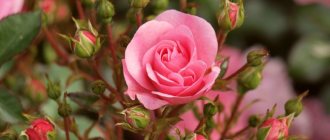Home rose (Rose) is a beautiful flowering shrub from the Rosaceae family .
One of the oldest plants. In the “History” of Herodotus (5th century BC) roses from the luxurious gardens at the palace of King Midas are mentioned. The flower has been grown indoors since the 19th century. House rose is a perennial plant, grows up to 65 cm. Compact bushes with a height of 15 cm are popular and convenient for indoor growing . With good lighting and sufficient moisture, it develops intensively. It blooms starting from the end of March, up to 3 times a year for 2.5 weeks.
In autumn, the bush prepares for hibernation and does not bloom as luxuriantly as in spring, but autumn flowers also delight with their elegant appearance and delicate aroma. With good additional lighting, winter flowering is possible.
| Average growth rate. |
| Blooms starting from the end of March, up to 3 times a year for 2.5 weeks |
| The plant is grown with little difficulty. |
| Perennial. |
Useful properties of domestic rose
Home rose is a valuable raw material for the preparation of medicinal products that improve the functioning of the entire body. Petals are a storehouse of vitamins and minerals. Infusions, decoctions, ointments, teas, and extracts are prepared from them. Used in cooking and winemaking.
Rose oil improves immunity, restores cells, and is used in cosmetology and perfumery. Inhaling the aroma calms and relaxes. The contemplation of a blooming rose evokes aesthetic pleasure.
How to choose a potted rose
Miniature roses in pots are a wonderful decoration for any interior. But, unfortunately, these flowers are difficult to care for. It often happens: you buy a potted rose with bright, beautiful flowers in a store or garden center, and after a few weeks or months they fade and die.
What is the reason? How to choose the right rose in a store so that it will delight you and your loved ones for many years?
Of course, roses, and even indoor ones, are difficult to care for. Therefore, it is important to choose a rose wisely when purchasing.
Experts advise not to buy potted roses with fully bloomed flowers. Roses in active bloom are beautiful. But what will happen to them next? What happens to the rose after it blooms? Will the whole bush wither along with the buds?
At the flower shop, choose a miniature rose in a pot with a small number of buds. make sure there are green shoots growing on the bush. If the plant is in the growth stage, then it will better take root in your home when the microclimate changes.
At the flower shop, carefully inspect the potted rose you are going to buy: there are no insects or cobwebs on the flowers and leaves. A healthy plant should have green, uniform leaves without spots. Never buy a plant whose leaves are falling off.
On the first day at home, do not replant the purchased potted rose into a new pot. A transplant is always stressful. It is best to leave the purchased miniature rose bush alone for at least a day. Transplant the flower into a new pot the next day or every other day.
Photo: Arne Nordmann, HitroMilanese, SoulofSax, Attilio Mileto, Antekbojar.
Author: Lady Venus · Published 04/15/2015 · Updated 08/28/2018
Rose is one of the most favorite flowers of many women. She is considered the queen of flowers, as she has beauty and a pleasant aroma. Many women would like to have a rose that can be grown indoors. However, its indoor appearance is demanding and capricious to care for, so for beautiful flowering it is necessary to make considerable efforts.
Content
Caring for roses at home (briefly)
The rose develops well at home if the conditions of its maintenance are met.
| Temperature | In summer – no higher than + 26°C, in winter – cooler, within + 6 – 16°C. |
| Air humidity | The average, 50%, is maintained by spraying the undersides of the leaves. |
| Lighting | Allows direct sun for several hours a day. |
| Watering roses | When the soil dries out by 2.5 cm - in winter - 1, and in summer - 2 - 3 times every 7 days. |
| Priming | Neutral or slightly acidic flower soil; independently prepared from sand (perlite), peat and humus (1: 2: 2). |
| Feeding and fertilizer | From spring to autumn - complex liquid fertilizers after watering (once every 14 days), you can use organic matter. |
| Transplanting roses | When the roots fill the pot; young bushes - every year, in a new pot larger (2.5 cm) in size, adults - as they grow, in the same pot, cutting off the roots. |
| Reproduction | From August to March - by rooting the tops or cuttings from the middle parts of the shoots in a mixture of sand and peat (temperature + 18 - 20 ° C). |
Caring for a rose is simple, but there are some peculiarities in growing roses. To get beautiful bushes, they are pruned regularly - after flowering and in the spring. In summer, the plant benefits from air baths; it is taken out into the garden or onto the balcony (choose a place protected from drafts).
Distinctive features for a house plant
Watering an indoor flower is described as abundant , but it is important that the soil in the pot does not turn into a dry lump of earth. Also, if you flood the plant with water, this can lead to rotting of the root system. Therefore, watering a flower should be treated with prudence. You also need to put a tray and provide a drainage system in the pot, this will allow the plant not to rot from excess moisture and completely saturate the soil in the pot. Water spilled into the pan should be poured out 10-15 minutes after watering.
How often to water?
The frequency of watering depends on the degree of drying of the soil, as well as on the season when watering occurs.
Dependence on various factors
The dependence of watering changes when the seasons change , since wintering gives way to a period of rapid growth, and each individual species needs a specific approach depending on the number of leaves, the abundance of flowering and the amount of moisture consumed.
Depending on the season - nuances in summer and winter
In summer, the plant requires abundant moisture and additional feeding. Therefore, the regularity of watering can be once every three to four days. The best option is to test the soil; if it is dry, it needs moistening.
If the weather is sunny, then watering should occur once every one or two days, and on cloudy days it is worth spraying the leaves of the plant and reducing watering to once every three to four days.
You cannot spray the plant on sunny days, as this can lead to leaf burns.
- In winter, the plant’s nutrition is minimal, so it is necessary to reduce watering and the application of mineral fertilizers, since the plant is dormant.
From the type of flower
Hibiscus, for example, is sensitive to air and soil humidity, so you should carefully monitor its watering, which is best done through a tray. We pour water into the pan and wait until it is absorbed into the ground. Also, leaves and inflorescences need to be sprayed periodically . If you do not follow the rules, the leaves may wither and fall off, as well as the buds.
How much water do you need?
It is necessary to water the flower so that the soil is sufficiently moist, but not flooded. Make sure that the earth does not squelch, and place a tray down so that excess water drains from the ground and the roots of the plant do not begin to rot.
What to irrigate with?
The plant should be watered only with water that has settled for at least a day or with filtered water. It should be at room temperature.
Caring for roses at home. Details
The flower, which has been decorating southern gardens for thousands of years, has been successfully cultivated as a houseplant for the last 200 years. A rose at home will develop harmoniously if it is surrounded with attention and care.
Home rose blooming
The blossoming of a rose is a beautiful and long-lasting spectacle.
Long stems adorned with glossy green leaves with jagged edges produce delicate flowers with velvety petals in a variety of colors. The domestic rose is an unapproachable beauty, protecting its charm, covering its stems with thorns. But this protection does not interfere with admiring the beauty of the plant and enjoying its fragrance. The flowering of the bush begins at the end of March and occurs in waves. For experienced gardeners, the rose blooms three times during the year.
To stimulate the appearance of new flower buds after the end of flowering, the shoot with peduncle is shortened by 7–10 cm or faded flowers with peduncles are cut off. Soon new flowers appear at the cutting sites. In autumn, fewer of them are formed, and they are smaller in size than spring roses. To ensure that the home rose blooms in winter, additional bright lighting is installed.
Rose dormant period
The domestic rose blooms luxuriantly during spring and summer, faithfully giving away its strength. But like any living creature, she needs rest. The dormant period of roses falls in winter. At this time, it stops growing and does not bloom, sometimes losing leaves.
In order for the plant to rest and fully regain its strength, it is kept in a cool room at a temperature of about 0°C, after shortening the shoots to 15 - 10 cm.
They do not stop watering, but do it no more than once every 7 days.
Temperature
The domestic rose is a delicate flower. In order for the leaves to be elastic and the rose to bloom beautifully, home care requires observing the temperature regime. The plant tolerates coolness much more easily than heat. At temperatures above + 26°C it can shed leaves or buds.
To cool the bush, it is sprayed. In winter, the flower can be kept on an insulated loggia or simply brought closer to the window glass. The home rose tolerates temperatures from + 6 - 16°C well. At this time, watering is reduced to avoid root rotting. It is important to regularly ventilate the bush, but it should be kept away from drafts.
Spraying
Home rose is responsive to spraying.
The procedure is carried out with settled lukewarm water or a fertilizer solution (you can take “Cascade”). Spraying is useful for the prevention of some diseases of roses, as foliar feeding and for maintaining air humidity in hot weather within 50%. Spray the lower part of the leaf with a spray bottle, avoiding the buds. Do this in the evenings or in cloudy weather: it is important that bright sunlight does not fall on the wet leaves.
Lighting
Proper lighting is very important for flowers. House roses should receive up to 5 hours of direct sunlight per day. It is good if the window on which the plant is placed faces west, southwest or east. But you also need to be careful with the rays of the sun: constant exposure to the sun can lead to yellowing of the leaves.
In order for the bush to form symmetrically, not stretch out and be beautiful, it is periodically turned over on the windowsill, exposing different sides of the flower to the light. Sometimes in spring a rose is planted in open ground. In this case, for the first time it is covered with non-woven material so that it takes root better and does not freeze.
Watering a rose
Home rose is a moisture-loving crop, but watering will be beneficial only when there is no stagnation of moisture.
To prevent water from stagnating in the pot, you need good drainage and loose soil. Only then will the roots be able to “drink” and absorb nutrients. In summer they usually water up to 3 times, and in winter - once a week. But to make sure that watering is necessary, a dry stick is immersed in the ground and, if the soil is 2.5 cm dry, watered (it is important not to allow the soil to dry out more or less). For irrigation, use lukewarm, settled water.
Primer for roses
The soil for roses needs to be loose, breathable and fertile. House rose prefers a soil mixture with a neutral or weak acidity level (pH from 6 to 7.5). In the store they buy a substrate for flower plants and improve it with sand (perlite).
You can make the soil yourself by taking 3 parts of garden soil and humus to 1 part sand (another option: 2 parts peat and humus to 1 part sand). A drainage layer made of expanded clay or pieces of brick is placed at the bottom of the pot.
The soil is periodically loosened and mulched after watering.
Feeding and fertilizer
Feeding and fertilizer are necessary for the growing season of the plant. From spring to autumn, the rose is fed once every 14 days with mineral liquid fertilizer for roses (alternate with organic fertilizer). In autumn, the amount of fertilizing is reduced. Fertilize with a concentrated mixture diluted 2 times after watering.
Make sure that just before flowering, the domestic rose does not receive a lot of nitrogen, otherwise you may not wait for flowering, but the bush will grow upward. Sometimes foliar feeding is carried out (in cloudy weather or in the evening, without getting on the buds). After transplantation, feed the bush no earlier than 14 days later.
Rose transplant
A rose flower at home needs to be replanted.
Young bushes are transplanted annually into a container whose diameter is 2.5 cm larger than the previous one. Adult plants are replanted as they grow, when the roots cover the entire lump of earth. The roots are shortened slightly to stimulate the appearance of appendages. You can leave the pot the same. After purchasing, a domestic rose must adapt to new conditions, so it is not replanted immediately. Work with the plant carefully, trying not to damage the roots. The planted rose is watered, sprinkled with dry soil and mulched. After 2 weeks, you can feed the roses for the first time.
Pruning domestic roses
Roses are pruned regularly in the spring - after awakening and after flowering. If the bush is not pruned for the winter, in the spring the shoots are shortened so that at least 3 buds are preserved (the top one should face outward). If the domestic rose has formed thin shoots directed inward, they are removed. For normal growing season, it is enough to leave 5 or 6 shoots. After the end of flowering, cut off the faded flowers with peduncles. The cut areas are sprinkled with crushed coal.
The domestic rose is a plant of average difficulty in keeping. But the queen of flora requires careful care so that she can fully express her beauty.
When and how does it bloom
Very often, roses in stores bloom in winter, disrupting the normal cycle. This occurs due to the introduction of drugs that stimulate flowering.
Blooming indoor roses in the interior
Once settled at home, the flower will restore the natural course of processes.
Flowering period
Individual species of this plant bloom differently. The flowering period depends not only on the species, but also on what time and where it was bred.
Typically, flowering is observed in spring and summer, since the rose is a heliophyte (light-loving plant), and under favorable conditions it can bloom in winter. In the southern regions, it blooms once every three months and even more often; if comfortable conditions are created, the roses will bloom every 2 months, from spring to autumn.
The small flowers of some varieties are completely odorless, while others emit a strong aroma. The flower lasts about two weeks.
Additional Information. Typically, indoor rose flowers do not cause allergic reactions.
Changes in care
Once flowering begins, roses require more frequent watering, purchasing and fertilizing once a week.
Rose propagation by cuttings
Getting new roses from cuttings is a simple and affordable way to get a new bush. A cutting is cut from the central part of a faded shoot so that the cut line is at an angle of 45°C and 10 mm below the lowest bud. At least 2 buds and about 10 leaves are left on the cuttings, the rest are removed.
The cutting is placed in an inclined position in a damp mixture of sand and peat. At a temperature of about + 19°C, rooting occurs in 2 – 4 weeks. Rooted cuttings are planted in the ground carefully so as not to break the fragile roots. The root collar is not buried. After planting, shade a little to help adapt to the new environment.
What else is included in the care?
Caring for an indoor rose includes many more aspects, let's consider the main ones:
We invite you to watch a video about caring for indoor roses:
With a properly installed watering system, the rose will delight you for a long time; it will bloom regularly and for a long time, from the first warmth until late autumn. Treat your purchased pet with care and thrift, and it will undoubtedly put you in good spirits, even on the most gloomy and sad days.
Diseases and pests
Sometimes a home rose starts to look bad. This indicates that it was attacked by diseases and pests. Common signs of rose damage include:
- yellow dots on the leaves, domestic rose leaves turn yellow and fall off - spider mite attack (increase humidity by spraying and warm shower; treat with Fitoverm 3 times with an interval of 10 days);
- white coating on rose leaves - damage by black spot or powdery mildew (spray with fungicides, soda solution - 1 tsp per 500 ml of water or with the drug "Skor");
- the leaves and buds of the rose fall - dry air, little moisture, the rose is hot, a reaction to a sudden change of place (spray, water, try to avoid a sudden change of place);
- the roots of the rose rot - overflow (if all the roots have rotted, the plant has died; if some of the roots are intact, the damaged ones are removed, the whole ones are washed in potassium permanganate and replanted in new soil; monitor watering);
- the stem of the rose rots - it is infected with blackleg - a fungal disease that is practically untreatable, the bush dies;
- the rose dries - dry air; stands next to the battery; the plant does not absorb nutrition from the soil because the roots have rotted (spray, monitor watering; rearrange; remove damaged roots);
- leaves dry, curl and fall off - damage from aphids (remove affected leaves; wash the plant with green soap, rinse well after 20 minutes; use Iskra);
- the stem turns black or gray, plaques appear – fungal infections (treated with “Fitosporin”);
- deformation of the leaf plate - a viral disease (damaged leaves and shoots are removed, the conditions for keeping the rose are improved).
A caring gardener, having purchased a plant, will immediately try to create optimal conditions for its development, then many problems can be avoided.
What care is needed at home?
What to do after buying a flower in a pot? Start caring for your rose immediately after purchase . Once you have removed the packaging film, inspect it carefully. Cut off dry twigs and blackened shoots. Experienced flower growers also advise getting rid of buds and flowers, since stimulated flowering greatly weakens the rosette.
Even if no pests are found, the plant must be washed under a warm shower. This should be done to prevent spider mites. Treatment with an antifungal drug (Fitosporin) will also not be superfluous.
Where to put?
Indoor roses are light-loving and it is advisable to place them on southern and south-eastern windows , while avoiding direct sunlight on the flowers. Ideally, light from 16 to 18 hours a day. If there is insufficient lighting due to housing or climatic conditions, fluorescent lamps can be used. In summer, flowers will look good on the balcony. You can take them in pots to your summer cottage and place them in a flower garden in a shaded place.
So, in the summer the rose is actively developing, it needs to be watered regularly, fed and sprayed in a timely manner. In autumn, when the air temperature drops, the growth rate of roses decreases. Therefore, feeding the plant stops and watering is reduced.
In winter, for the one that has delighted you with its flowering for so long, it is time to rest. It's time to adjust her height. Each branch is trimmed with a sharp knife, leaving no more than five buds on each branch. Now the flower can be removed to a darker and cooler place, about 10°C. In spring, a rested rose will have fresh leaves and begin to grow again.
Types of domestic roses with photos and names
There are many types of domestic rose. At home it is convenient to grow compact bushes with miniature flowers: patio roses (grow in paved courtyards and at home), polyanthus (multi-flowered) roses, Cordana roses.
Variety "Baby Masquerade"
A narrow bush up to 0.3 m high with branched shoots. There are few thorns. Small dark green leaves. Small flowers form inflorescences of 6–10 pieces. During flowering, the color of the petals changes (chameleon flowers) from lemon to pink and red. Subtle smell of fruit. Resistant to diseases.
Variety "Angela Rippon"
A miniature bush (height - up to 40 cm) with branched shoots and many flowers, formed in inflorescences of 5 pieces. The width of the flowers is up to 4 cm. They have a strong smell. Dark green small leaves. No pruning needed; Feed often little by little. For prevention, they are treated against black spotting and powdery mildew.
Variety "Easter Morning"
The dense, straight shoots bear hard, dark green, glossy leaves. The flowers are soft cream, densely double, form large inflorescences of up to 27 pieces. It blooms almost without interruption. Has a subtle aroma. The variety is resistant to fungal diseases.
Compact bushes of the Fire Princess variety
The height of compact bushes is up to 40 cm. Branched shoots look upward. Glossy green leaves with jagged edges. Double orange-red flowers on the tops of the shoots form inflorescences of 5 pieces. Possible damage to powdery mildew and black spot.
Compact rose bushes are popular among indoor flower lovers. They are easy to care for and pleasant to watch. Despite its wide distribution, the domestic rose continues to remain a uniquely beautiful flower, delighting and surprising with its variety of species.
Characteristics of an indoor rose
The relatively small size of the plant allows it to be grown in pots rather than in open ground. And although the name of the flower is “indoor”, and the classic house rose is a small bush, today you can also find larger species, reaching one meter in height.
The classic bush grows up to half a meter, has hard carved or elongated leaves, thick stems covered with thorns, and bright flowers. The variety of colors includes white, cream, yellow, everything from pale pink to bright red.
The species diversity of roses is so great that you can find specimens completely different from each other. There are bush, creeping, climbing, and standard varieties. Therefore, every gardener can choose the right plant for himself.
Homeland of the plant and history of cultivation
The history of the origin of the plant is not known for certain. There are many opinions on this matter. Some believe that the birthplace of the flower is Europe, others are inclined to think that it is China, and others believe that the plant spread from Southeast Asia.
Be that as it may, today it is known that miniature rose bushes were already grown in ancient Rome. And although ornamental plants were not typical for the Romans, they were planted in flowerpots and used indoors.
An indoor rose is a plant bred artificially. This is the result of a lot of breeding work on crossing many types of roses. Thanks to this, today there are many species and varieties that have an attractive appearance and different maintenance requirements.
Names and descriptions of species with photos
Not all types of house plants will feel comfortable in an ordinary apartment. Nevertheless, the variety of varieties, their appearance, maintenance requirements and sizes allow you to choose exactly the bush that will meet your wishes and future maintenance conditions. The main types, their description and appearance are presented in the photo:
- Bengal is a small bushy bush, ideal for those who cannot tolerate intense aromas. The leaves are pointed and slightly flattened. Flowers can be of various shades. It was this species that was first brought to Europe, and for a long time was the only variety of flowering domestic rose.
Bengal
This species is unpretentious in care, easily tolerates normal air humidity, and pruning, if required, is infrequent. Usually only dry or diseased branches are removed. Loves loose soil with plenty of drainage. - The tea rose originated from the Bengal species. This variety is the result of breeding work to combine miniature and ordinary garden tea flowers. Came to Europe from India. The sizes of bushes are very varied.
Tea room
There are dwarf varieties that do not exceed 30 cm, and there are also giant ones that reach two meters. The standard size is within half a meter. The flowers are colored in a variety of colors and exude a pleasant aroma, quite intense. The leaves on the stems grow densely and are light green in color. Ideal for keeping in apartment conditions. - The Chinese rose differs from others in that its small flowers almost completely cover the bush, forming a kind of hat. This is why the Chinese rose is valued by many gardeners.
Chinese - Polyantha is a highly branched but compact bush, not exceeding 50 centimeters. There are subspecies with double flowers, or collected in a raceme. As the result of long breeding work, the polyanthus rose is suitable for both indoor and outdoor cultivation. At the same time, it feels good both on the windowsill and on the balcony. Among its most popular varieties are Miniature, Clotilde and Orange Triumph.
Polyanthus - Baby Masquerade is a low compact bush, not exceeding 30 cm. A distinctive feature of the plant is the almost complete absence of thorns on fairly dense stems. The leaves are dark, medium-sized, and have a glossy surface. Flowers can be 3-4 cm in diameter. They are collected in inflorescences and change color several times during the entire flowering period, moving from light yellow to pale pink. This species is disease resistant and blooms almost continuously.
Baby Masquerade - Bourbon rose is a miniature bush with double flowers that are quite large for its size. It blooms for a long time, until the beginning of winter, but then sheds its leaves and rests until April. From this time on, new shoots begin to appear.
Bourbon - Remontant is a popular and unpretentious species. Blooms almost all year round. Flowers can have a variety of colors and are medium in size. The buds are goblet-shaped.
Remontantnaya - Rose Hummingbird has its own peculiarity - flowers of various shades from yellow to orange. The size of flowers collected in inflorescences is 4-5 centimeters. The bushes are compact, dense, up to 35 cm in height. This plant blooms several times a year.
Hummingbird
Of course, species diversity is not limited to these varieties. However, they are considered the most suitable for growing in ordinary apartments.
What kind of rose pot?
A new rose pot should be larger than the container in which the plant was sold, at least 2-4 cm in diameter and 5-7 cm in height. You shouldn’t take a pot that’s too big either; The above-ground part of the plant should correspond to the volume of the pot as 1:1.
Interesting materials:
How to lock a PS4 joystick? How to preserve a sea worm? How to shade a shape in Visio? How to color cells in Excel Hotkeys? How to paint over greasy stains on the ceiling? How to fix paint on clothes? How to dock a toolbar in Excel? How to pin a message in Tims? How to attach a drill bit to a drill? How to pin a tab?

